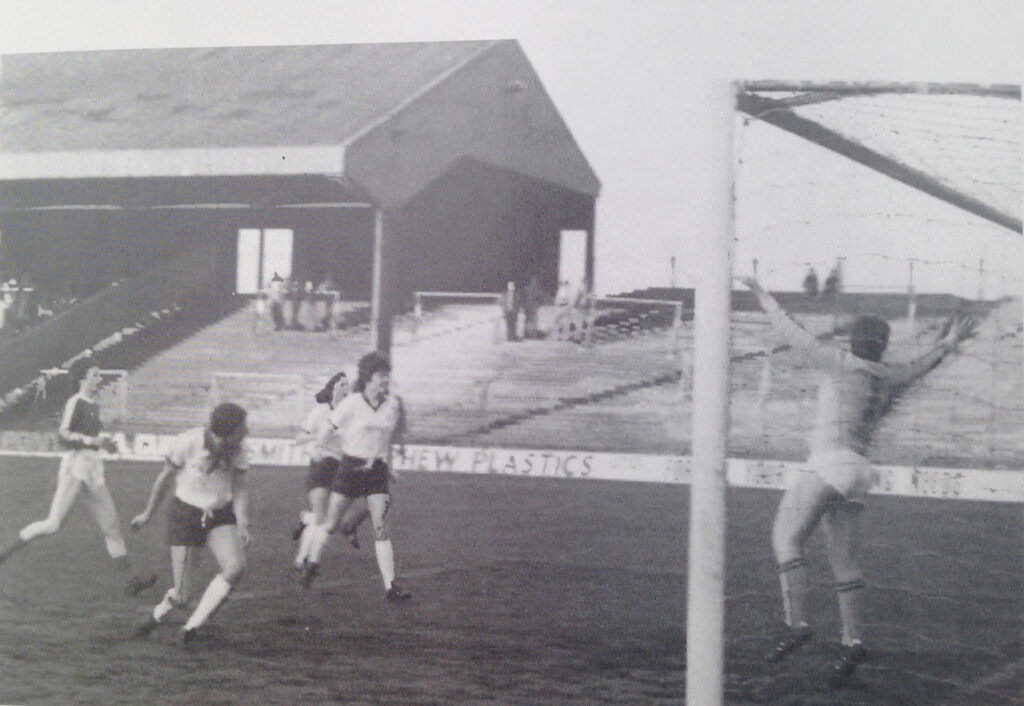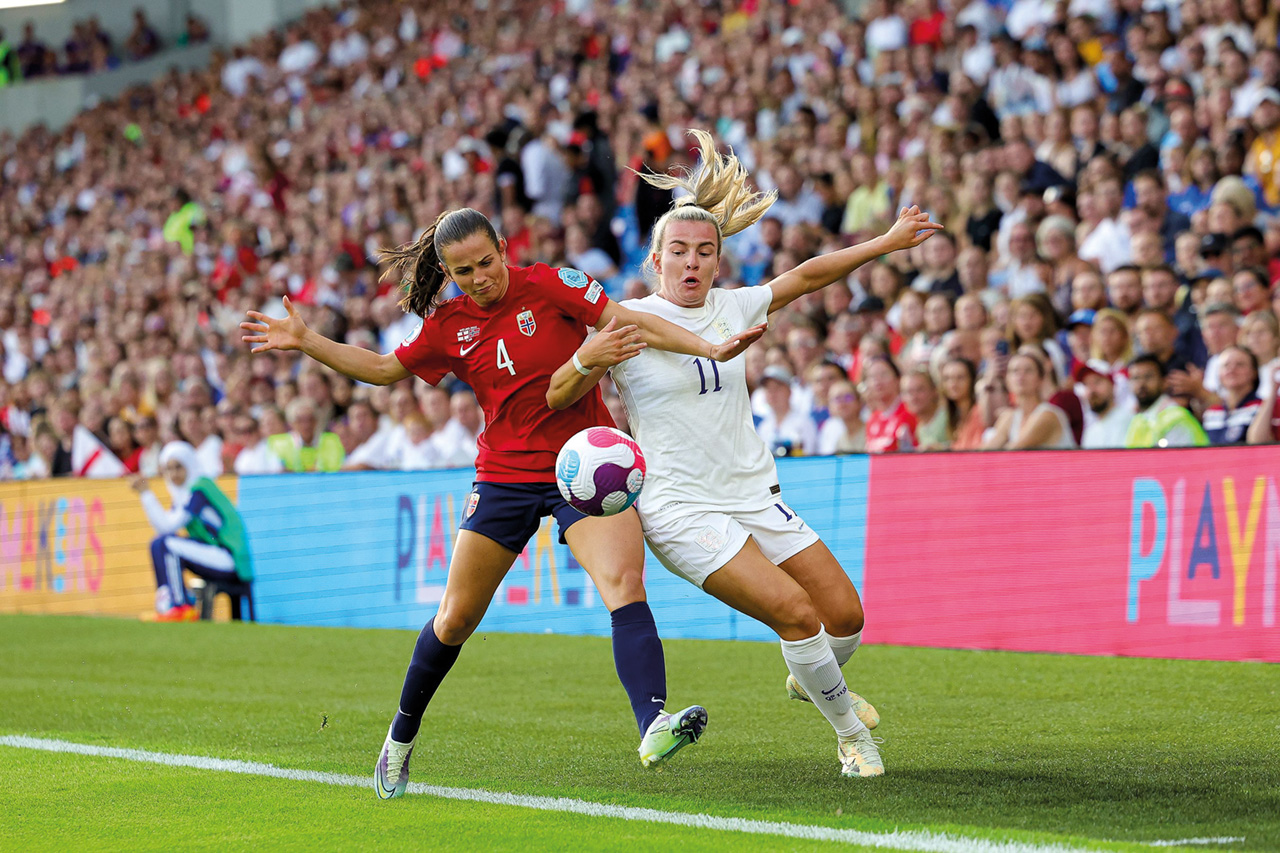Women’s net gains
The Lionesses are in the semi-finals of the Euros and the country’s getting behind women’s football. But if it’s the biggest boom in the women’s game, it’s certainly not the first
As the fog left by the pyrotechnics cleared, the crowd roared and play began under the floodlights at Old Trafford on 6 July it was hard not to get emotional. The oh-so-familiar sights and sounds associated with the big football matches were present. Yet, the situation was decidedly abnormal. Abnormal because this was not a Premier League football match or a match in a major men’s international tournament, but a women’s match – the opening match of a home Euros to be precise, between England and Austria.
Factory teams played against each other up and down the country, raising money for the war-wounded
The Lionesses are not unaccustomed to big crowds. At the 2019 World Cup they played in some of the biggest stadia in France. They have played at a sold-out Riverside, at Wembley twice, at St Mary’s, the Britannia and Elland Road – to name a few. But at Old Trafford something felt different. This was not a crowd of people there to experience cheap seats, there just to be a part of a major tournament or there out of curiosity. This was not a passive crowd but one expectant and engaged like never before in a team of women’s footballers and the journey it is on.
There is something quite magical about the moment when the abnormal feels normal. For more than a century, women have fought to play football, fought for the right to be physically active and to be able to have fun through sports. For so long, women’s football has been tolerated at best or discouraged, scorned and outright banned for periods of time at worst.
On Wednesday night it felt like arms had been laid to one side, that there was no need to fight anymore. Of course, there is still plenty to fight for, but it felt like hearts and minds were being won to the cause in large numbers.
England laboured somewhat to a1-0 win to kickstart their Euro Championship campaign, but as Sweet Caroline echoed through the ground on the full-time whistle, mirroring the scenes last summer, they had secured a bigger victory.
For many watching, that moment and this summer’s Euros will seem like the latest crest on an ever-rising wave, that women’s football has been steadily progressing to this point. Hopes are even higher after England’s spectacular 8-0 win over Norway took them through to the quarter-finals.
That story of progress is broadly true of the last 10-15 years, but the history of the women’s game is far richer and full of far more pitfalls than perhaps many realise.
Women have been connected to football for as long as it has existed. The earliest example of a game played with a ball and the feet was a game called cuju, which was played in China and dates back as far as the Han Dynasty of 25CE-220CE. Even at that stage, there is – albeit limited – evidence of women having also enjoyed kicking balls around and watching the sport.
By the late 1800s, the first signs of women playing the game as we recognise it today are evidenced, with the first international match, between teams representing England and Scotland, played in Edinburgh in 1881. In 1894 a women’s rights campaigner, Nettie Honeyball (believed to be a pseudonym), launched the British Ladies’ Football Club. The BLFC played regularly for two years, defying heckles, mocking and even physical attacks on their games, which were also viewed as a novelty. Honeyball’s intentions were made clear in an interview she did with a newspaper at the time, where she explained that the decision to found the club was because she wanted to harness the power and popularity of football to challenge the outdated views towards women in society generally and further their emancipation.
Women’s football would experience its biggest boom, until the present day at least, in the 1920s. During the First World War men flooded to the front and women filled the hole left by them in workplaces up and down the country. In the factories, much like the men who formed factory teams to boost the morale and fitness of the workforce, women began playing. The games were actively encouraged in some cases, as the importance of a healthy workforce to productivity was known and any morale booster during the war was much needed.
With men’s football suspended, the women’s game thrived. Factory teams played against each other up and down the country, raising money for the war-wounded in the process. Tens of thousands would file into stadiums to watch the best teams of the day play and, in 1920 a peak crowd of 53,000 filed into Goodison Park to watch Dick, Kerr Ladies (formed in the Dick, Kerr & Co factory based in Preston) play St Helen’s Ladies.
That crowd would set a club record that would last 98 years, up until March 2019, when Atletico Madrid hosted Barcelona in front of 60,739 fans – a record since broken by Barcelona’s91,648 at the Camp Nou in April 2022.
Why did it take so long for that record to be broken? It’s simple. Within a year of the game at Goodison Park the FA banned women’s football from all affiliated grounds. The governing body justified the move by describing the game as “unsuitable for women” to be playing.
That ban lasted close to 50 years, finally being lifted in 1970. There were a number of reasons for the U-turn on women playing the game. In the post-war period, attitudes towards the role of women in society took a step back. With men returning from the war, it was time for women to return to the homes where they belonged. Doctors were lined up by the FA to espouse the line that women weren’t made for football. However, there was another reason too. With the war over, women’s teams switched the focus of their fundraising from the war-wounded to causes closer to home, including supporting striking miners and their families. This was unsettling for the establishment. By this point teams were raising huge sums of money outside of their control and it was becoming political, so they acted to crush it.
The impact of the ban was huge. It meant that women’s matches were forced into local parks, athletics stadiums or rugby grounds and the capacity for large crowds was scuppered.
Teams played on, with Dick, Kerr Ladies playing until the 1960s, but they became peripheral, existing outside mainstream consciousness, and gradually women playing football became abnormal.
When the FA lifted the ban in 1970, with the founding of the Women’s FA putting on pressure and Uefa having made moves to recognise the women’s game, it did not burst to life. The women who played during the nearly 50-year ban were not suddenly elevated and supported. But FA recognition at least allowed for some of the stigma to lift a little. In many ways, the lifting of the ban was less about the FA wanting to do it and more about a fear of something growing and developing outside its control again.
It wasn’t until 1993 that the FA took control of women’s football from the WFA and, despite the FA launching the Women’s Super League in 2010, it wasn’t until 2017 that it conceded it had “let down” women’s football with the lengthy ban.
That is the context to today’s explosion of interest and investment in women’s football. Just as women have had to battle for the right to equal pay, for abortion rights, for maternity rights, and more, they’ve also had to fight for the right to play football and to enjoy physical fitness.
This summer’s Euros presents an opportunity for the game in England to be catapulted into the public consciousness like never before and tear down many of the remaining barriers to the participation of women in the “national sport”. The Lionesses have a realistic shot at the title, which would extend that reach even further. It is an exciting time.
A Woman’s Game: The Rise, Fall, and Rise Again of Women’s Football by Suzanne Wrack (Faber) is out now

A new, all-female football team of 11 “players” drawn from diverse corners of the women’s game, from ex-England internationals to an 11-year-old equality campaigner, supporters’ club founders and pioneering female coaches, comes together as part of Around The Match, a multimedia project exploring the struggles and triumphs experienced over the last five decades of the women’s game.
Initiated by arts group We Are Willow, with Wigan Council, the project opened for the kick-off of the first Women’s Euro 2022 match in the town on 9 July.
The project raises many of the most poignant, funny and inspiring stories to show how much and how little has changed for women in the male-dominated sport.
It takes in film, photography and a range of memorabilia, including a match-day programme and football shirt, designed by We Are Willow and female fashion students from Wigan and Leigh College.
Capped by England 48 times, 68-year-old Liz Deighan describes the thrills and spills of her international career, which began in 1974.
Current players include Wigan Athletic’s Ellie Duffy who, at just nine years old, ran a high-profile campaign to highlight the injustice of the boys’ game restarting following Covid lockdowns while coaching and matches for girls had to remain paused. Starting a petition
and then taking the story to the media, Duffy campaigned for change and continues to fight
for the girls’ game.

Leave a reply
Your email address will not be published.